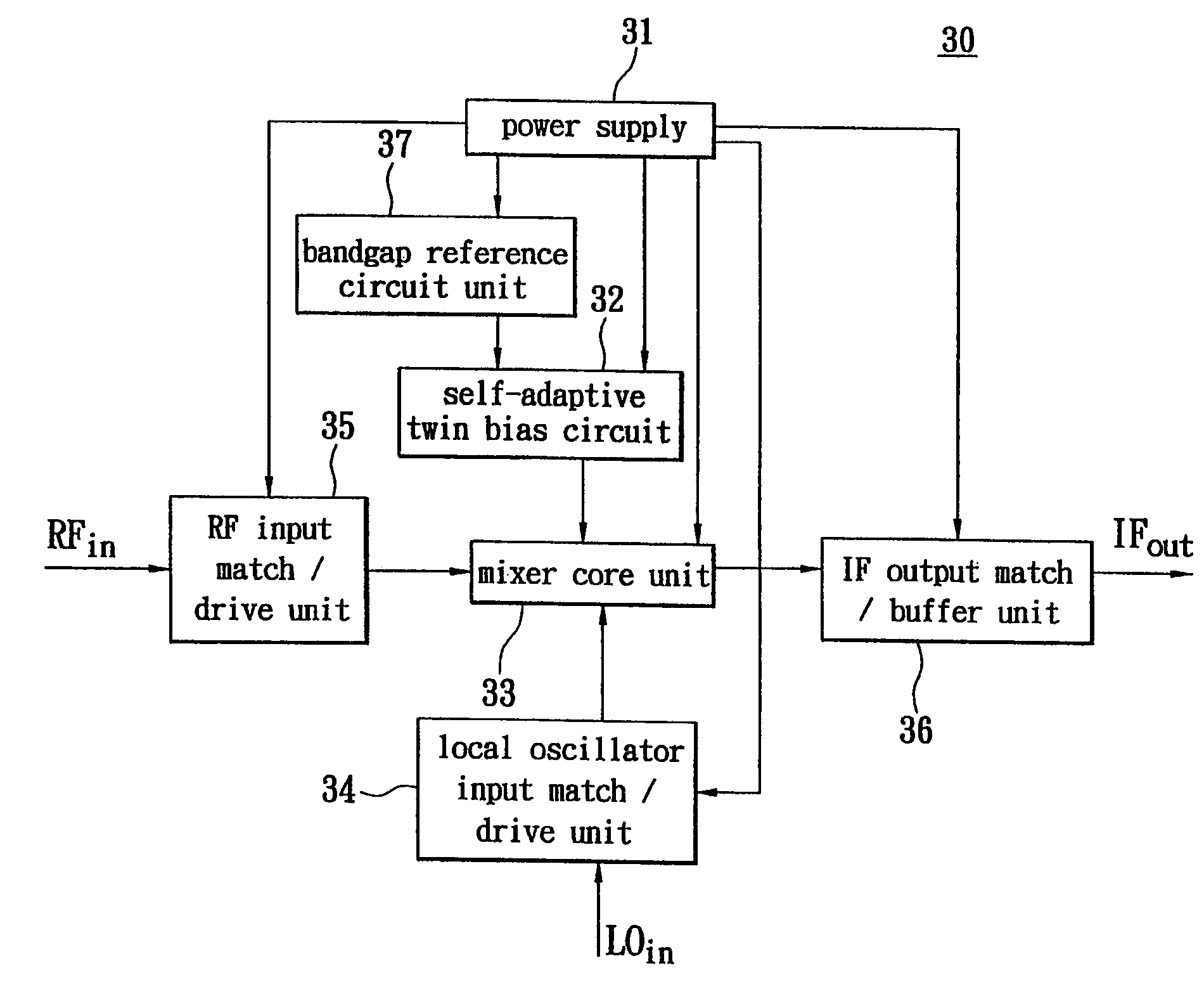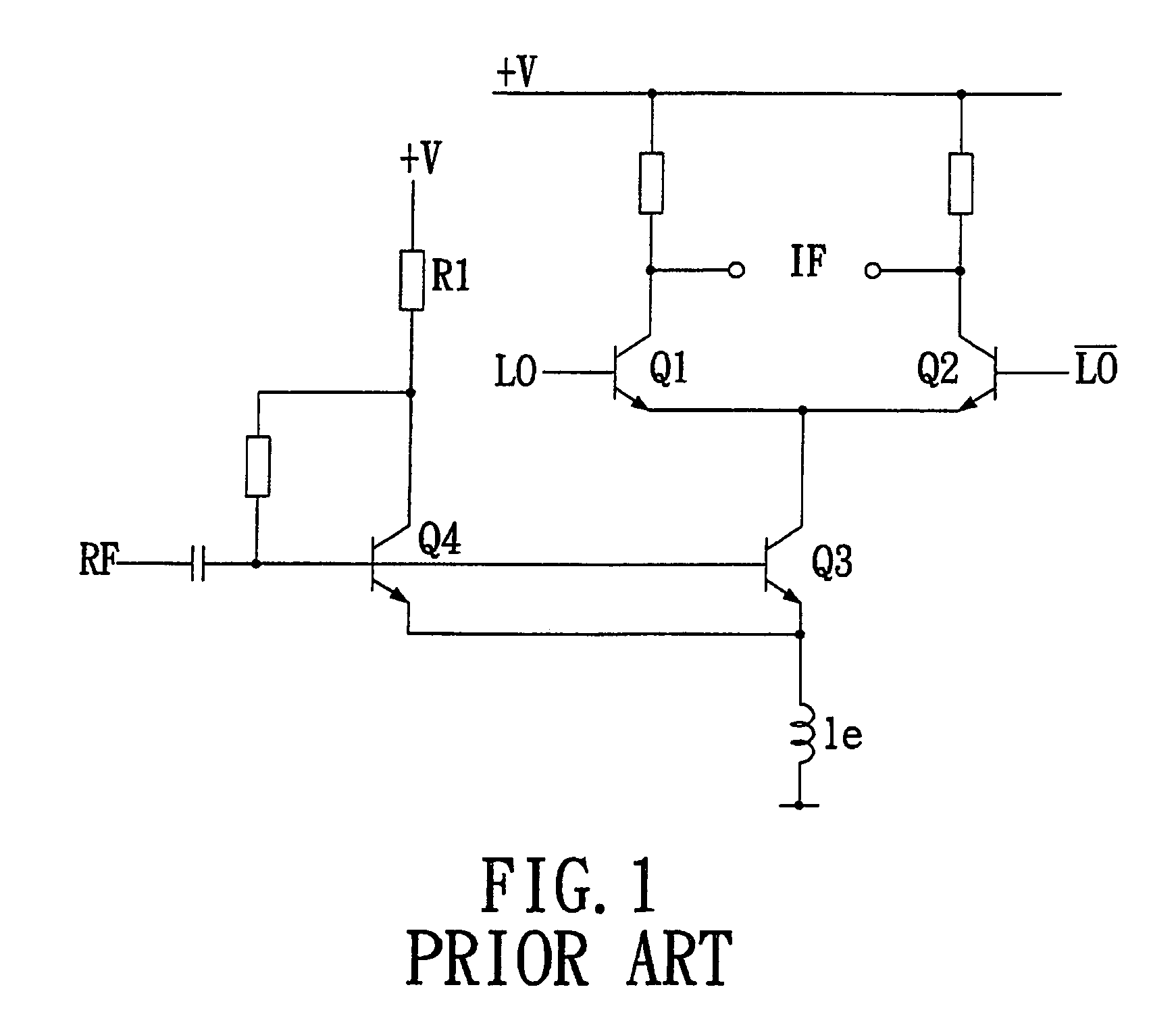Active mixer with self-adaptive bias feedback
a self-adaptive, mixer technology, applied in the direction of demodulation, radio transmission, transmission, etc., can solve the problems of increasing linearity that cannot yet meet requirements, the overall performance of the communication system is greatly affected, and the linearity of the mixer becomes quite poor, so as to improve the linearity of the conventional mixer, improve the temperature response, and increase the yield factor
- Summary
- Abstract
- Description
- Claims
- Application Information
AI Technical Summary
Benefits of technology
Problems solved by technology
Method used
Image
Examples
first embodiment
[0024]FIG. 4 is a linear bias circuit according to this invention. The linear bias circuit 40 according to this invention comprises a direct voltage source V4, a direct current source Is4, a first NPN transistor Q41, a second NPN transistor Q42, a first passive component Pc41, a second passive component Pc42, a third passive component Pc43, a fourth passive component Pc44, and a fifth passive component Pc45.
[0025]A direct voltage source V4 provides a direct voltage, while a direct current source Is4 provides a direct current. First, the collector of the first NPN transistor Q41 is electrically connected to a positive terminal of the direct voltage source V4, while the base of the first NPN transistor Q41 is electrically connected to a positive terminal of the direct current source Is4. Then, the collector of the second NPN transistor Q42 is electrically connected to the positive terminal of the direct current source Is4. Next, a terminal of the first passive component Pc41 is electr...
second embodiment
[0027]FIG. 5 is a linear bias circuit according to this invention. The linear bias circuit 50 according to this invention comprises a direct voltage source V5, a direct current source Is5, a first NPN transistor Q51, a second NPN transistor Q52, a third NPN transistor Q53, a first passive component Pc51, and a second passive component Pc52.
[0028]A direct voltage source V5 supplies direct voltage, while a direct current source Is5 supplies direct current. First, the collector of the first NPN transistor Q51 is electrically connected to a positive terminal of the direct voltage source V5, while the base of the first NPN transistor Q51 is electrically connected to a positive terminal of the direct current source Is5. Then, the collector of the second NPN transistor Q52 is electrically connected to a positive terminal of the direct current source Is5, while the base of the second NPN transistor Q52 is electrically connected to the emitter of the first NPN transistor Q51. Next, a termina...
third embodiment
[0030]FIG. 6 is the linear bias circuit according to this invention. The linear bias circuit 60 according to this invention comprises a direct voltage source V6, a first passive component Pc61, a second passive component Pc62, and a third passive component Pc63.
[0031]The direct voltage source V6 supplies direct voltage. First, a terminal of the first passive component Pc61 is electrically connected to a positive terminal of the direct voltage source V6. Then, a terminal of the second passive component Pc62 is electrically connected to the other terminal of the first passive component Pc61. Next, a terminal of the third passive component Pc63 is electrically connected to the other terminal of the second passive component Pc62, while the other terminal of the third passive component Pc63 is electrically connected to a voltage output terminal. At last, after the direct voltage source V6 supplies voltage and current, by means of voltage division from each component, a linear bias is out...
PUM
 Login to View More
Login to View More Abstract
Description
Claims
Application Information
 Login to View More
Login to View More - R&D
- Intellectual Property
- Life Sciences
- Materials
- Tech Scout
- Unparalleled Data Quality
- Higher Quality Content
- 60% Fewer Hallucinations
Browse by: Latest US Patents, China's latest patents, Technical Efficacy Thesaurus, Application Domain, Technology Topic, Popular Technical Reports.
© 2025 PatSnap. All rights reserved.Legal|Privacy policy|Modern Slavery Act Transparency Statement|Sitemap|About US| Contact US: help@patsnap.com



